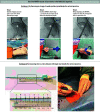A systematic algorithm for large-bore arterial access closure after TAVI: the TAVI-MultiCLOSE study
- PMID: 37982158
- PMCID: PMC10949328
- DOI: 10.4244/EIJ-D-23-00725
A systematic algorithm for large-bore arterial access closure after TAVI: the TAVI-MultiCLOSE study
Abstract
Background: Despite transcatheter aortic valve implantation (TAVI) having become a routine procedure, access site bleeding and vascular complications are still a concern which contribute to procedure-related morbidity and mortality.
Aims: The TAVI-MultiCLOSE study aimed to assess the safety and efficacy of a new vascular closure algorithm for percutaneous large-bore arterial access closure following transfemoral (TF)-TAVI.
Methods: All consecutive TF-TAVI cases in which the MultiCLOSE vascular closure algorithm was used were prospectively included in a multicentre, observational study. This stepwise algorithm entails the reinsertion of a 6-8 Fr sheath (primary access) following the initial preclosure with one or two suture-based vascular closure devices (VCDs). This provides the operator with the opportunity to perform a quick and easy angiographic control and tailor the final vascular closure with either an additional suture- or plug-based VCD, or neither of these.
Results: Among 630 patients who underwent TF-TAVI utilising the MultiCLOSE algorithm, complete arterial haemostasis was achieved in 616 patients (98%). VCD failure occurred in 14 patients (2%), treated with either balloon inflation (N=1), covered stent (N=12) or surgical repair (N=1). Overall, this vascular closure approach resulted in a minor and major vascular complication rate of 2.2% and 0.6%, respectively. At 30 days, only one new minor vascular complication (0.2%) was noted. In-hospital and 30-day all-cause mortality rates were 0.2% and 1.0%, respectively.
Conclusions: Use of the MultiCLOSE vascular closure algorithm was demonstrated to contribute to an easy, safe, efficacious and durable vascular closure after TF-TAVI, resulting in a major vascular complication rate of less than 1%.
Conflict of interest statement
G. Bieliauskas, L. Sondergaard, and O. De Backer received institutional research grants and consulting fees from Abbott. G. Tirado-Conte holds a research-training contract with ‘Rio Hortega’ (CM21/00091) from the Spanish Ministry of Science and Innovation (Instituto de Salud Carlos III). The other authors have no conflicts of interest to declare.
Figures




References
-
- Leon MB, Smith CR, Mack M, Miller DC, Moses JW, Svensson LG, Tuzcu EM, Webb JG, Fontana GP, Makkar RR, Brown DL, Block PC, Guyton RA, Pichard AD, Bavaria JE, Herrmann HC, Douglas PS, Petersen JL, Akin JJ, Anderson WN, Wang D, Pocock S PARTNER Trial Investigators. Transcatheter aortic-valve implantation for aortic stenosis in patients who cannot undergo surgery. N Engl J Med. 2010;363:1597–607. - PubMed
-
- Smith CR, Leon MB, Mack MJ, Miller DC, Moses JW, Svensson LG, Tuzcu EM, Webb JG, Fontana GP, Makkar RR, Williams M, Dewey T, Kapadia S, Babaliaros V, Thourani VH, Corso P, Pichard AD, Bavaria JE, Herrmann HC, Akin JJ, Anderson WN, Wang D, Pocock SJ PARTNER Trial Investigators. Transcatheter versus surgical aortic-valve replacement in high-risk patients. N Engl J Med. 2011;364:2187–98. - PubMed
-
- Leon MB, Smith CR, Mack MJ, Makkar RR, Svensson LG, Kodali SK, Thourani VH, Tuzcu EM, Miller DC, Herrmann HC, Doshi D, Cohen DJ, Pichard AD, Kapadia S, Dewey T, Babaliaros V, Szeto WY, Williams MR, Kereiakes D, Zajarias A, Greason KL, Whisenant BK, Hodson RW, Moses JW, Trento A, Brown DL, Fearon WF, Pibarot P, Hahn RT, Jaber WA, Anderson WN, Alu MC, Webb JG PARTNER 2 Investigators. Transcatheter or Surgical Aortic-Valve Replacement in Intermediate-Risk Patients. N Engl J Med. 2016;374:1609–20. - PubMed
-
- Reardon MJ, Van Mieghem, Popma JJ, Kleiman NS, Søndergaard L, Mumtaz M, Adams DH, Deeb GM, Maini B, Gada H, Chetcuti S, Gleason T, Heiser J, Lange R, Merhi W, Oh JK, Olsen PS, Piazza N, Williams M, Windecker S, Yakubov SJ, Grube E, Makkar R, Lee JS, Conte J, Vang E, Nguyen H, Chang Y, Mugglin AS, Serruys PW, Kappetein AP SURTAVI Investigators. Surgical or Transcatheter Aortic-Valve Replacement in Intermediate-Risk Patients. N Engl J Med. 2017;376:1321–31. - PubMed
-
- Mack MJ, Leon MB, Thourani VH, Makkar R, Kodali SK, Russo M, Kapadia SR, Malaisrie SC, Cohen DJ, Pibarot P, Leipsic J, Hahn RT, Blanke P, Williams MR, McCabe JM, Brown DL, Babaliaros V, Goldman S, Szeto WY, Genereux P, Pershad A, Pocock SJ, Alu MC, Webb JG, Smith CR PARTNER 3 Investigators. Transcatheter Aortic-Valve Replacement with a Balloon-Expandable Valve in Low-Risk Patients. N Engl J Med. 2019;380:1695–705. - PubMed
Publication types
MeSH terms
LinkOut - more resources
Full Text Sources
Miscellaneous

